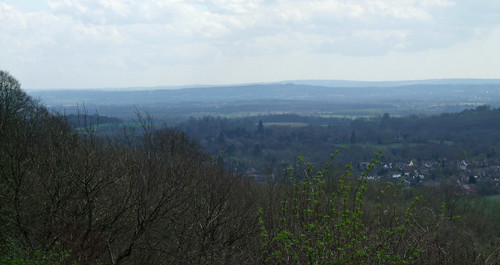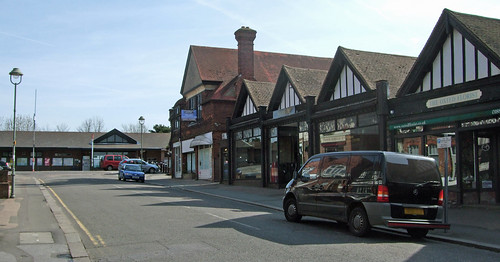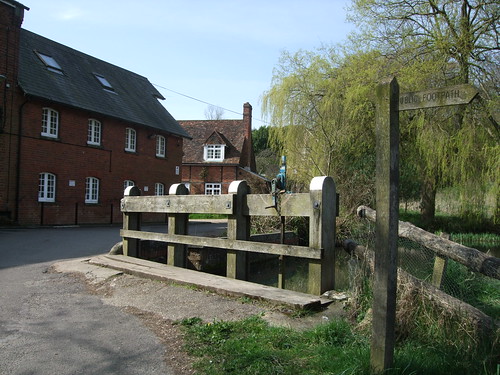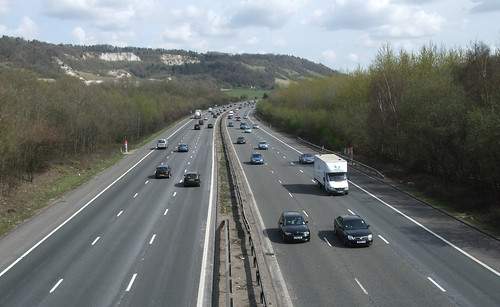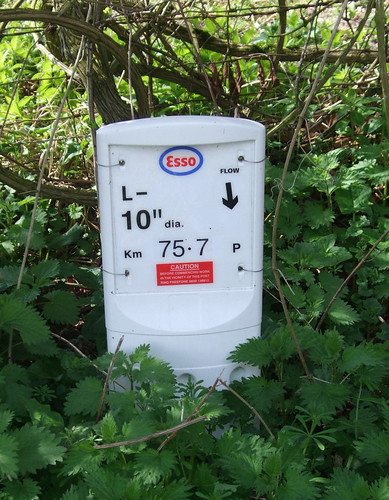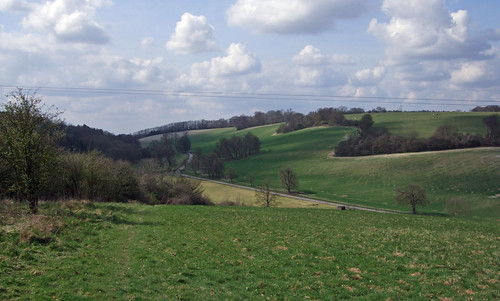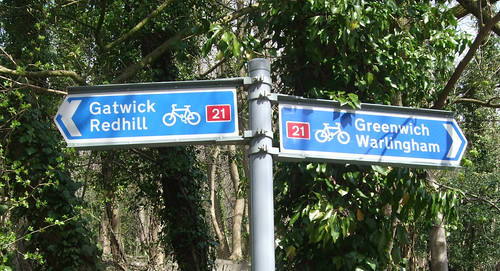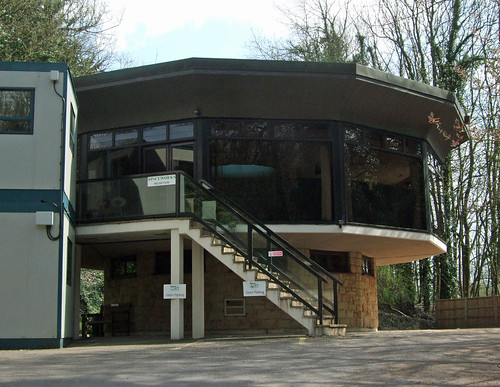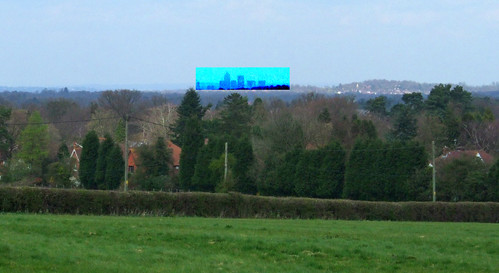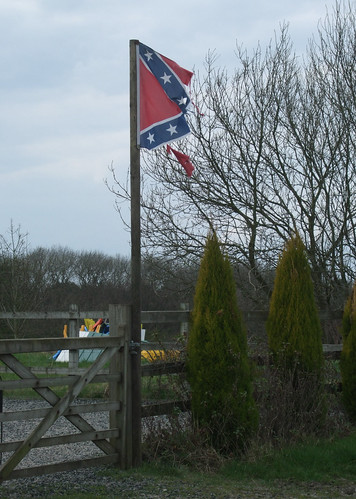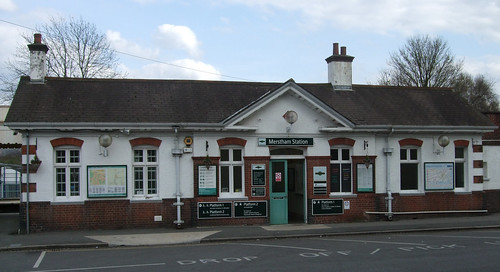
Today's walk veers back towards the North Downs after negotiating the motorways at Merstham and then clings to the ridge pretty much all the way, following the North Downs Way National Trail through some of the most celebrated beauty spots of the Surrey Hills, including Reigate Hill and Box Hill. Unfortunately the weather isn't kind to me -- Easter Sunday dawns mild but misty and the thick veil of water vapour refuses to lift. The view from the ridge, which on a clear day stretches to the South Downs, is little more than a featureless white haze. Still, I remember the first time I walked these paths, on a day in early May in the early 1990s, I got caught in an unseasonal blizzard.
I've already discussed the geology of the chalk ridge when we first encountered it (London Countryway 18: Sole Street - Borough Green). The history of the North Downs Way is less than a blink from the perspective of geological time, but as a long distance walking route, it's ancient. Chalk trackways may have begun as animal tracks, but were undoubtedly in use by humans in the days when you could still walk across land from England to Flanders.The ridges offer long lengths of uninterrupted contours, obvious navigation, well-drained soil, springy turf that seems to shape itself to the passage of feet, and a lofty elevation that makes it harder to be ambushed successfully. They still just feel right to walk on, although the earliest walkers would not have appreciated the views we know today as the hillsides were well wooded in their natural state.
Alongside a growing interest in many other aspects of the natural and historic environment, the desire to identify and document Britain's ancient roads flourished in the Victorian era. It was apparently Ordnance Survey cartographers who first coined the term "Pilgrims' Way" for a specific line of tracks along the North Downs, on the assumption that it would have been used by pilgrims from Winchester Cathedral bound for the shrine of assassinated "turbulent priest" Thomas Becket at Canterbury Cathedral, and in the other direction by those aiming to pay their respects to St Swithun. The term was popularised by Hilaire Belloc and became part of folk geography, giving its name to various streets and other features along the route, some of which bear the oyster shell symbol associated with pilgrims on their name boards.
But it now seems the idea of a Pilgrims' Way was a romantic notion with little basis in fact, and has led to a number of misunderstandings. Firstly, it immediately makes most people think of Geoffrey Chaucer's anthology of lengthy narrative poems The Canterbury Tales (c 1400). But Chaucer's fictitious pilgrims set off from Southwark, not Winchester, so would have followed the old Roman road, Watling Street, predecessor of today's A2, which we encountered near the beginning of our journey just south of Gravesend. Secondly, the trackways long predate both Becket and Christianity -- archaeological finds go back to 500BCE and there is every reason to suppose these paths were trodden long before that. A more technical issue is that the idea of there being a specific, designated route reflects a modern reductionist approach to transport topography -- in fact in many places there are several parallel tracks at different heights on the ridge, so Pilgrims' Ways would be slightly more accurate.
The Victorian interest in the outdoor environment became one of the strands in a movement for better access to the countryside for everyone, including working class people in Britain's industrial cities, which achieved a sharp political focus in the inter-war years. Towards the end of World War II, as the vision of an egalitarian and beneficient welfare state for the new peace developed, countryside access was one of many items on the agenda of the government think tanks charged with shaping the post-war world. Two government commissioned reports by committees chaired by John Dower (1945) and Arthur Hobhouse (1947) led to the National Parks and Access to the Countryside Act 1949, which in England and Wales put in place the current framework for the management of public rights of way and led to the creation of National Parks, Areas of Outstanding Natural Beauty and what were then called Long Distance Paths. The paradigm this act put in place has limitations which have become increasingly evident in the face of social change, particularly as regards exercise -- notably an assumption that the kind of countryside access most worth facilitating is a challenging walk in the hills, of the sort that even in mid-century already held a relatively narrow appeal -- and the process of implementation proved lengthier and more challenging than can possibly have been foreseen in the mood of post-war optimism.
Those Long Distance Paths were a reflection of the shopping list of the outdoor access movement -- their particular founding manifesto is usually taken to be Ramblers General Secretary Tom Stephenson's 1935 article in the Daily Herald calling for a "long green trail" along the Pennines, inspired by the development of wilderness trails in the national parks of the USA. The embryo of today's public rights of way system already existed, but these paths were generally short routes based on local use. The government, argued the walking movement, should also be developing longer routes that link paths together seamlessly with new links where needed, and maintaining them to a high standard to provide hours and days of uninterrupted good walking. The Hobhouse Committee agreed, and so another everyday English phrase sprouted capital initials and came to designate the outcome of a bureaucratic process governed by statute and managed by a government agency.
These days Long Distance Paths have been rebranded as National Trails and fall within the remit (in England) of Natural England, an agency of the Department for the Environment, Farming and Rural Affairs (Defra). NE funds them 75%, the rest picked up by local authorities, and appoints managers to oversee each one. The process for creating them is still governed by the 1949 act and involves a lengthy and expensive process that culminates in the route being signed off by the relevant Secretary of State. Progress since 1949 has been agonisingly slow -- it took 26 years before the first one, the Pennine Way, was opened throughout.
Meanwhile, as the role that recognised, named and signed routes could play in promoting walking, and particularly walking tourism, became more evident, less cumbersome methods of creating non-statutory routes were found, usually through partnerships of local authorities, user groups and, sometimes, land managers, and taking advantage of the powers given to councils in 1968 to waymark rights of way. Thus the confusing situation in Britain where there are now very many named and signed routes -- "promoted routes" as they're known in the trade -- supported by a number of different agencies, but only a handful of National Trails. We've already encountered quite a few -- from well-established and well-signed non-statutory recreational walking routes like the Wealdway and Greensand Way to the short circular walks promoted by the National Trust on their own land.
The Pilgrims' Way was originally on the Hobhouse list but investigation revealed that much of the length of the way originally named on OS maps was now part of the metalled road network and of course it was out of the question that these paths could be reclaimed from traffic. So a route was created making use of sections of various parallel trackways, many of them higher up the ridge, and to save potential confusion and a challenge to the canonical status of the OS route, the new trail was named the North Downs Way, opening in 1978. It follows the line of the Downs from Farnham to Dover, with an additional long loop running via Canterbury. At the western end, for reasons I'm not aware of, the national trail itself falls short of that other pilgrim destination, Winchester, though in recent years Hampshire council have plugged the gap with the St Swithun's Way between Winchester and Farnham. Before the Thames Path was opened the North Downs Way was the closest National Trail to London, actually grazing the boundary in the southern reaches of the London Borough of Bromley, and it's also been designated part of European Path E2, more of which on a later walk.
National Trails in England and Wales have for decades been waymarked with a standard acorn symbol -- I don't know why it was chosen specifically but it's stylised, easily reproducible and recognisable. The oak is a stereotypically English tree so perhaps this played a part -- oak leaves feature in other logos we've encountered such as the National Trust and Woodland Trust. Perhaps also the creators of the national trail logo were thinking of the proverb "From little acorns...", though a rather unexpected crop of mutant oaks has sprung up from this particular glans.
As previously noted, the London Countryway leaves the national trail temporarily to run through Merstham station and past a tiny fire station that's now been converted for private use.
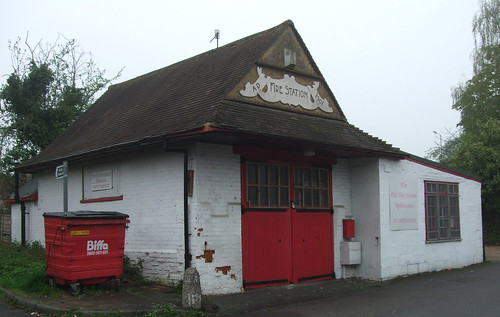
It soon catches up with the national trail again leaving town via Quality Street, once part of the High Street and offering a particularly fine lineup of historic residential buildings, some of which date back to the 16th century. The Old Forge was the home of actors Seymour Hicks and Ellaline Terriss, celebrated in their day for their performances as leading characters Major and Miss in the West End production of JM Barrie's play Quality Street (1902), and the street was later renamed in their honour, no doubt to the delight of local estate agents. Today the name is more likely to conjure up images of toffees and chocolates consumed to excess at Christmas from large tins. Halifax confectioner Mackintosh (now part of Nestle) referenced the play when it branded its enduring assortment in 1936, though the images of the Major and Miss long featured on the packaging were based on the children of the original brand designer rather than the likenesses of Hicks and Terriss.
From now on the Countryway will stay welded to the North Downs Way to the end of the section, apart from a diversion of my own making. Leaving Quality Street to the ghosts of late Victorian stereotypes, I climb gently but steadily uphill through a golf course, where early bird golfers look suitably ghostly themselves in the thick mist, with the roar of the M25 clearly audible -- the route parallels it for some time. This section of route was also walked by Iain Sinclair in his millennial psychogeographic anticlockwise pedestrian excursion around the motorway recounted in his book London Orbital. Mertsham golf course prompts him to observe drily that "without golf, the M25 would be entirely encicled by smears of oil seed rape, boarding kennels and deconstructed Victorian asylums. Golf stetches the suburban lawn into the motorway landcape; the kiddies' sandpit, the lake that is not to be fished or swum."
The path runs between hedgerows and emerges by the main entrance to the Royal Alexandra and Albert School, where an impressive lodge and gateposts indicate this was once more than simply a school building. In fact it's the gateway to the extensive estate of Gatton Park, originally a manor dating back before Domesday. In the mid-18th century it was owned by the Colebrook family who had the grounds made over by leading landscape gardener Lancelot "Capability" Brown. His characteristic rolling green "natural" landscapes are still in evidence, the first example of his work we've encountered. Back then the estate was notoriously one of the "rotten boroughs" where, thanks to mediaeval privileges, a handful of easily paid-off electors had the right to return Members of Parliament while rapidly growing industrial cities like Manchester and Birmingham remained disenfranchised. The estate even has a town hall -- a neo-classical folly that must surely have been built as a self-conscious celebration of the abuse of democracy -- now open only on specific days. In 1830 Frederick John Monson bought the estate specifically for its political privileges. Two years later, Parliament abolished them. The last private owners were the Colman family of Norwich mustard fame -- all in all, quite a history.
The school dates back to a charitable institution, a school for orphans established at Hoxton, just outside the City of London, in 1759. Anti-slavery campaigner William Wilberforce, who seems to crop up a lot on London walks, was once a governor. In 1948 it merged with another orphan school originally founded in honour of Prince Albert, Queen Victoria's consort, and, through a complicated arrangement with Surrey County Council, relocated to Gatton Park, which had been requisitioned from the Colmans during the war. The council's involvement means that though a boarding school, unusually it is also a state school, and charges relatively low fees. The school only occupies part of the original estate -- most of the rest is now in the hands of the National Trust, and the estate management is coordinated by a partnership called the Gatton Trust. As announced on the gateposts, the grounds are managed under the Countryside Stewardship scheme, where land managers receive funds to manage for conservation and to allow access, our first encounter with this category of land.
I don't detour to visit the church and town hall but stick to the signed North Downs Way route which runs past a fine chapel building looking like it dates from the 1960s and past a great piece of public art by a sculptor called Peter Dawson tacked on the end of a building -- I can find out little else about him or the work.

In the mist I also miss the Millennium Stones which bear various religious and philosophical quotations from each of the past ten centuries, including Eliot's prodding for the still point of a turning world. It's odd to be walking so close to school buildings in these paranoid times, although the numerous CCTV cameras are some evidence of the Colditz-style security that these days normally separates schools from public space.
Now in the National Trust section of the estate I pass the first of a number of retro-styled black bollards rather resembling vicious mediaeval weapons that waymark the Discover Gatton walk, a round tour of the estate.
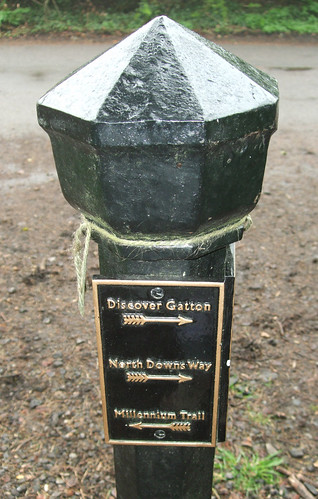
The bollards also indicate the route of the North Downs Way and the "Millennium Trail". As the world must now be littered with Millennium Trails, it's worth pointing out the one in question is the Reigate & Banstead Millennium Trail, which is another of our links to London -- although it doesn't actually cross the boundary, it does link to the London Loop where the latter route makes one of its forays out of London at Banstead Downs. The trail will stay with us now as far as Reigate Hill.
I emerge past information boards on Gatton at Wray Lane car park, a site managed by Reigate and Banstead council that's well known for offering an extensive and panoramic view from the Downs -- except today, where the arrows indicating far landmarks point optimistically at blank nothingness, a fantasy limbo of the sort where Q might transport Captain Picard for a spot of crass moral debate in a Star Trek episode where they were running short of cash for sets. The highlight of the car park is its long-established refreshment kiosk, mentioned by Chesterton, a very welcome sight the day I walked through the unseasonal blizzard and still there today dishing out tea, cakes and sandwiches for consumption on the surrounding picnic seating. There are toilets too. It's not long since breakfast and I don't really need to, but I can't resist buying a cuppa and a slice of Victoria sponge. A few other dog walkers, leisure walkers nad cyclists are out and about despite the mist, also patronising the kiosk. I love finding places like this on walks -- I think I even treasure them more than some of the obvious "heritage" attractions. I hope the kiosk by the pub at High Beach in Epping Forest is still there by the time we get round to it.
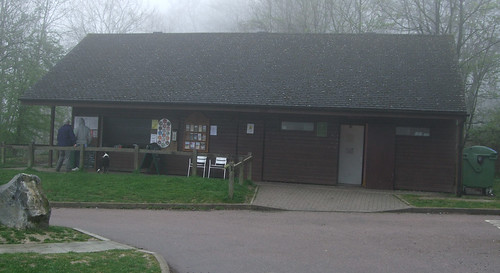
A convenient footbridge behind the kiosk takes me across the A217, which zigzags precariously down the chalk ridge here into Reigate. There's a steeper descent, but a more pleasant walk, on a footpath that leaves our route to the left a little way past here if you want to head into Reigate. Otherwise it's back into National Trust land -- making up for last week's Trust-free walk, well over half of today's route must be through Trust property -- past Reigate Fort, one of the best preserved of the London Defence Positions, a chain of forts built along the Downs in the 1890s when Britain feared invasion by France, reinforcing the defensive capacity of this natural wall around London. The forts weren't permanently staffed but designed to be occupied at short notice by mobile contingents. They quickly came to be regarded by the military as obsolete and were sold off in 1907. The Trust had owned this fort in a derelict state since 1932 but at the turn of the millennium got a grant to restore it for public visits -- it's been open free of charge since 2007. It's atmospheric in the mist, but difficult to imagine looking out with your finger on the trigger in the expectation of the French army appearing over the Greensand ridge. Behind the fort a water tower and mobile phone mast loom up dramatically through the trees.
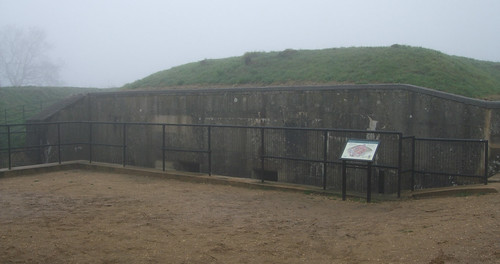
We're now on Reigate Hill viewpoint, at 220m (the seventh highest point in Surrey) normally offering fine views, with the commuter conurbation of Reigate and Redhill, swollen from the nucleus of an old market town, nestling on the flat ground between the chalk and greensand. A short walk further on and part of the same parcel of land managed for public access is Surrey's sixth highest point, Colley Hill (230m), surmounted by a curious neo-classical temple-style round shelter with a beautiful blue mosaic ceiling depicting the zodiac. It looks like it's escaped from Portmeirion, a Venetian alchemist's fantasy. Stumbling upon it on his M25 walk during a stretch of "the sort of walking guidebooks promote" on the North Downs Way enhanced Sinclair's sense of unreality.
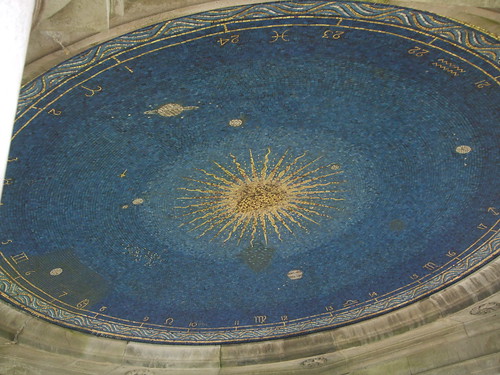
Near here, by a fence, the Millennium Way snakes away downhill on its way to Gatwick, also providing a link to the Greensand Way which runs to the other side of the urban area.
Finally the path along the top of the open slope ends at a gate leading to a wooded space near houses and you feel very much like you've crossed into a new zone. Indeed you have -- this is an old parish boundary now the boundary of Reigate and Banstead Borough and the neighbouring Mole Valley District, and historically it was also one of the boundaries of one version of London, or at least London's influence. The evidence is still there in the form of a white post just past the gate bearing a white shield with a red cross and an upside-down sword, or "argent a cross gules, in the first quarter a sword in pale point upwards of the last", part of the arms of the City of London.
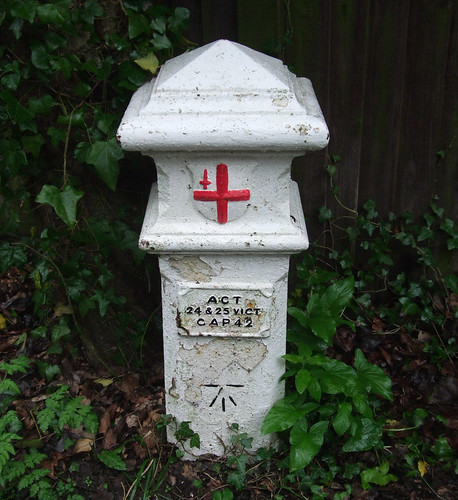
London developed from a cluster of mediaeval urban "cities" and boroughs treasuring their own independence, and surrounding rural areas and villages that fell under traditional counties -- Middlesex, Surrey, Kent and later Essex -- administrated mainly by parishes that combined both civil and religious functions, and until the mid-19th century there was no properly constituted civil authority coordinating what was, from a functional point of view, a single city. The most powerful body in London comparable to a local authority was the City of London Corporation, which could claim a legacy dating back to pre-Norman conquest times and which represented the core of the city and its business interests. And so in the vacuum surrounding it the corporation came to exercise influence and powers way beyond its traditonal boundary, the so-called "one square mile" of the City itself.
The City of London had been exercising powers to tax coal and other commodities entering an extensive area beyond its own boundaries since mediaeval times, powers confirmed in various royal charters and later legislation. In the 19th century the City began staking out its territory with posts and bollards marking the limits of its taxation powers, and in 1861, after a new act consolidated these powers and defined a revised area over which they could be exercised, the City began a programme of marking points where paths, roads, rivers, canals and railways crossed this boundary with standard cast iron posts and plaques which came to be known as "coal posts". Around 200 of these have survived, not all in their original positions. The example here is fairly typical of a wayside post, and there's another one just round the corner, of a slightly different, squatter design. Interestingly, the contemporary boundary of Greater London established in the 1960s occupies a lesser area than the 1861 tax boundary, despite the huge growth in urban development during the intervening century.
Another curiosity by the coalpost is a public footpath that appears to go through a wooden door, presumably into the world of Narnia.

My path now descends sharply downhill on a spongy earth track -- a sign at the top warns of the steep descent and it isn't joking. There are sheer slopes above, partly the result of previous quarrying of chalk and the prized "Reigate stone", and at several points piles of chalk nuggets are piled up against the fence above the path, apparently having cascaded down the hillside. At one point a circular plastic tunnel about 30cm in diameter has been pierced through an earth bank sloping downhill to my right -- whether for drainage or ambulatory animals of some sort I don't know. Heading downhill I finally start to lose the noise of the M25 as both the route and the motorway veer away from each other.
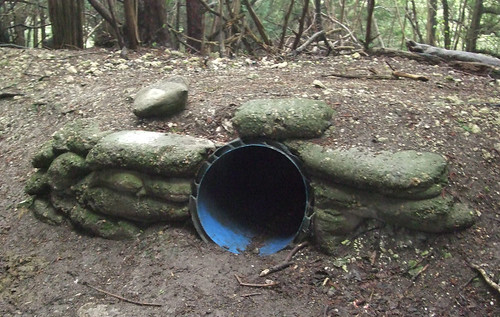
Near the bottom of the slope the North Downs Way turns back along the contour line again, this time only a few metres up from the foot of the ridge, on a trail along the bottom of the National Trust's Juniper Hill. Chesterton really likes this path, which goes on for a good 3km with scrubby slopes to the right and fields to the left, some of them full of what appear to be strangely shaped haystacks despite the season, but in the damp conditions the mix of chalk and clay has formed a sticky, slippery path surface, a bit like walking on bread dough that's been made with too much water.
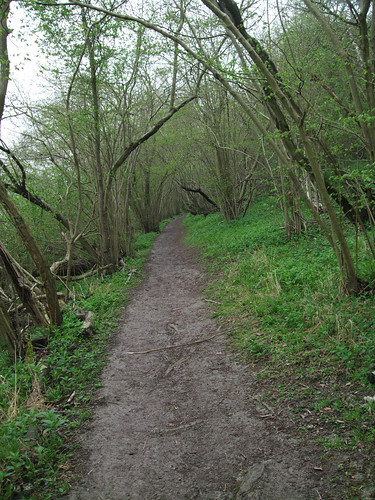
In places, rainwater mixed with chalk has streamed across the path, forming rutted puddles and staining the grass white, as if someone's gone ape with one of those devices used for marking out sports pitches. It's quite tiring keeping my balance on the narrow path and by the end of it I'm longing for some nice hard tarmac. Part of the route is along a wider track that passes some spectacular tree routes, clinging to the ridge and studded with chalk fragments.
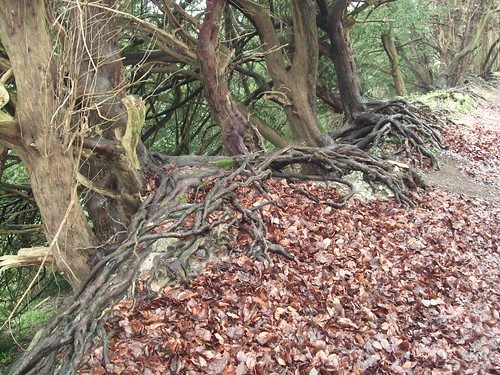
Eventually, to negotiate a road and quarry ahead, the North Downs Way deviates south onto the flat farmland below the ridge. Here Chesterton's verbal description seems to follow the current route of the national trail and doesn't quite correspond to his outline map -- he says changes have been made for safety reasons. I decide to explore an obvious alternative route, about the same distance and giving a direct rail connection at Betchworth station, so I continue on the bridleway that's led me off the Downs, passing some attractive farm buildings and reaching a level crossing, complete with attractive keeper's cottage, at the end of a lane. A pleasant path now hugs the railway line, crossing it (and temporarily leaving the AONB, the southern boundary of which runs along the line here) through its own secluded little tunnel and continuing on the other side up the edge of a railway cutting.
The railway is the North Downs Line between Reading and Gatwick, one of the few in the region that isn't a radial route from London -- it was opened by the South Eastern Railway in 1849 so that passengers travelling from the west to the south could avoid the hassle of changing between London terminals, so it's actually a fragment of a potential orbital line, although it once offered through trains from Reading to Charing Cross via Redhill. In the most recent reshuffle of the private companies that now run Britain's passenger rail services under franchises, it was allocated to First Great Western, whose principal business is operating westwards from Paddington via Reading. Betchworth is a rustic station that makes much of its position as a gateway to the AONB, with a huge Surrey Hills logo and information boards.
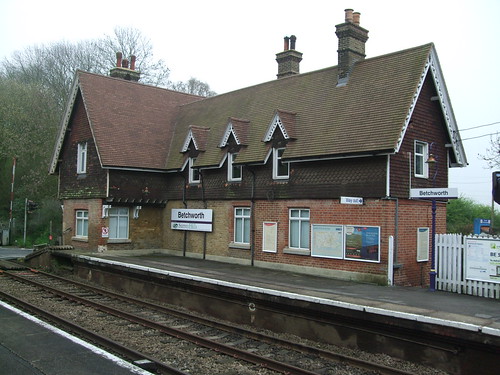
Betchworth was also the connection to the national rail network for the extensive system of standard and narrow gauge lines that served adjacent Betchworth Quarry and Brockhole lime pits, and it's round the site of these that I wander next as my walk rejoins the North Downs Way and regains the ridge. Climbing back through the woods I reflect that industry wasn't always something associated with large urban settlements -- primary industries like forestry, mining and quarrying have always taken place out on the land, and the immediate processing of their products, such as charcoal burning and lime making, formerly took place close to the source.
Besides its railway, Betchworth Quarry's other claim to fame is that following its closure in 1960 it became one of those notorious quarry locations chosen by the producers of TV science fiction as a quick fix for an alien landscape in the days before CGI made such things too easy. Both Doctor Who and Blake's 7 were shot here, and in one classic Who story of the T0m Baker era, 'The Deadly Assassin' (1976), the rails featured too, in a nightmare sequence where the Doctor is trapped in the "virtual reality" of the Matrix (decades before Keanu Reeves and the Wachowski Brothers discovered bullet time). In one scene our hero gets his ankle caught in railway points and is about to be run down by a locomotive driven by a mysterious masked assassin. The fact that the loco is a titchy narrow gauge model sadly fails to add to the menace.
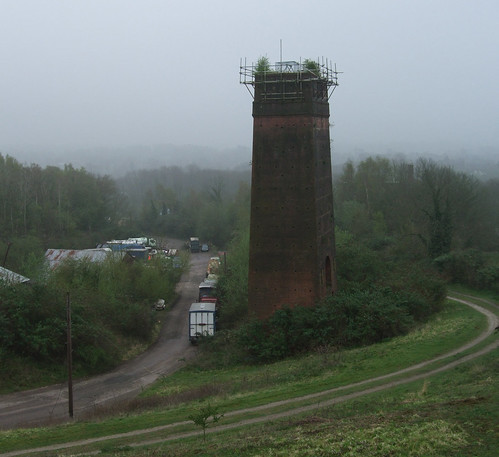
The lime works closed even earlier, in 1936. When Chesterton visited in 1981 some of the rail system was still in existence and operated as a museum. All this has now gone, although some of the locomotives are now in preservation, including one that featured in Wilbert (Reverend W) Awdry's Thomas the Tank Engine books. These days the site is managed as a nature reserve and Site of Special Scientific Interest by the Surrey Wildlife Trust, open to the public for free and with many of the lime works buildings still standing. This trust is one of a federation collectively known as the Wildlife Trusts, forming between them one of the country's biggest organisations managing nature reserves, often in partnership with local authorities and government bodies. We caught a glimpse of a neighbouring trust's reserve when overlooking Bough Beech reservoir in a previous walk, but this will be our first visit in London underfoot to a Wildlife Trusts reserve. "People and nature together have created a unique landscape," says the information board.
The path ups and downs bracingly around quarry edges and through mixed woodland, reaching the top of the ridge and quitting the nature reserve near houses and fully fledged grave complete with headstone that turns out to be for a racehorse, Quick, "an English thoroughbred" according to the inscription. We're now back in National Trust territory, in their Box Hill estate, and this isn't the only curious burial in the vicinity -- to the north of our route, near Box Hill fort (another of the London Defence Positions now being restored), is the grave of Major Peter Labelliere (1726-1800), who left a will wishing to be buried upside down, since the world was topsy turvy, and that his youngest son and his landlady's daughter should dance on his coffin -- although it may be this is just a memorial stone, and his remains are elsewhere in a more conventional grave.
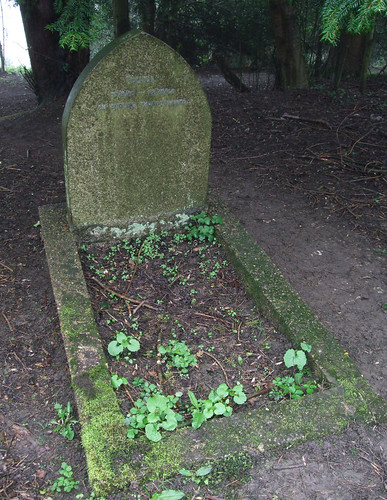
Through the woods I soon find myself walking parallel to the obviously named Zigzag Road, near the settlement at the top of the hill that is actually called Box Hill. Several sources, including a 1990s edition of the official North Downs Way guide, mention a Wimpy Bar here. Nostalgia overcomes me for this dowdy 1960s and 1970s British answer to an American fast food chain, once owned by Lyons of Corner House fame, with its formica tables, jam jar lid-size burgers, buns the colour of corduroy flares, and similarly flare-evoking Brown Derby desserts consisting of a tough old ring donut topped with chicken-fat-and-sugar soft ice cream. Wimpy still exists, forever trying to refresh its image, but not at the top of Box Hill -- instead I find the Smith & Western Steak House and Diner, located in a wooden chalet. A group of people wearing cowboy hats have just parked up and are heading for the door.
Box Hill (193m) is the first undisputed 24-carat beauty spot on the route. There are records of its being admired back in the 1650s -- diarist John Evelyn (who has numerous connections to London walks) found it "extremely agreeable" and it was one of the places that pleased the early 19th century Romantic taste for a particular form of apparently natural landscape, at a considerably shorter distance from London than better known Romantic favourites such as the English Lakes. John Keats and Jane Austen praised the place and as transport links to London improved it became a classic bank holiday destination for Londoners looking for some nearby natural beauty. The key areas were donated to the National Trust in 1914, and since then various adjoining parcels of land have been added to the public estate. Its popularity has certainly not decreased with the burgeoning car ownership of the post-war years, and it's also become known as "the best biker destination in the south of England."
So what's inherently special about Box Hill? It's not just the view from the top of the Downs -- there are numerous other points that offer equally wide views -- but also its position on the edge of the Mole Gap, where the river Mole has cut a sheer cliff through the chalk, described by the National Trust as "the finest natural river cliff in the county, if not in southern Britain." The eponymous box trees, along with yew, cling to the cliff. The Mole is the first direct tributary of the London Thames I've so far encountered: rising in the West Sussex Weald and running under the runway at Gatwick, after slicing through the Downs it flows northwest through Surrey suburbia to join the Thames just upriver from the latter's tidal limit at Teddington Lock. Other communication channels have taken advantage of the gap in the downs, notably the Roman road now known as Stane (Stone) Street from London to Chichester, now partly incorporated in the modern A24 trunk road. Dorking, a staging post on the Roman road and later an important market and coaching town, is laid out on the flat land upriver of the Gap, spread out beneath your feet as you stand on the springy turf of the hill.
At least, it is on a day when you can see more than 10m in front of your face. By the time I get to the viewpoint and trig point that are the focus of the site, the mist has lightened slightly -- you can at least see that there's something down there. Despite the mist, there's still a fair number of people out and about, undeterred from their Easter day out, and quite a cluster around the viewpoint.
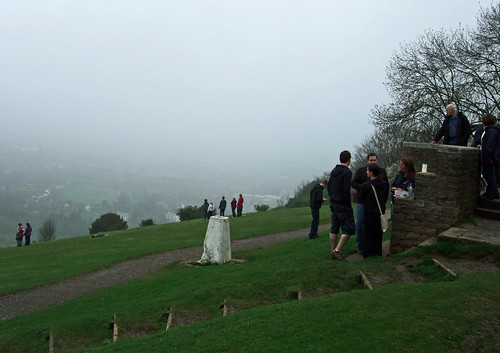
The path takes me through another band of trees and across another open slope, where a group of young men are enhancing their enjoyment of the hill with sausages fried on a camping gas ring a spliff or two, then down the precipitous descent through woods to the river, rendered more hazardous by damp conditions and sticky mud.
Safely at the bottom, I reach one of the site's other celebrated features, the stepping stones that still cross the stream at a centuries-old ford, although there is the choice of a more accessible footbridge a few metres downstream. When I first read about these stones I imagined some rickety old pebbles worn by centuries of running water, but the current stones are a streamlined, modern interpretation of this ancient method of river crossing, a set of solid, evenly sized and regularly spaced hexagons. And people love them -- one of the attractions of the place, especially for children, is simply to cross and recross the river on the stones. One interesting aspect of them, as well as being a pedestrian-only piece of infrastructure design, is that they are one-way only: each stone is only large enough to accommodate one person at one time, so while several people can move in one direction at once, it's impossible to cross safely in the opposite direction while someone is coming towards you, which requires contact and negotiation with fellow users on the opposite bank. I'm glad the stones survive and haven't fallen victim to the health and safety police.
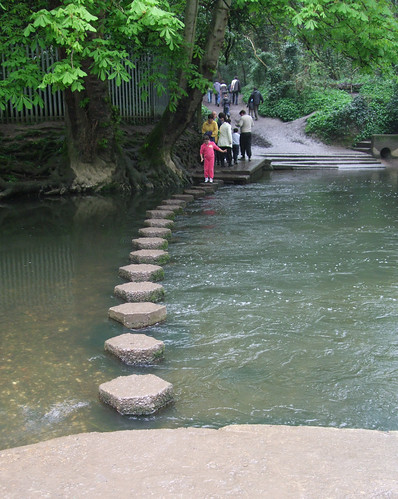
Emerging from the National Trust car park I reach Stane Street, now the busy dual carriageway of the A24. The Roman road starts at London Bridge and follows what's now the A3 via Elephant, Clapham and Morden, where the modern A3 heads for Portsmouth and the A24 inherits the ancient route to Chichester. And here it is still piggybacking on the Mole's cut through the downs, flat, straight and dualled, with spacious walkways and cycleways. Northwards a short way is the landmark Burford Bridge Hotel, now the Mercure Burford Bridge, where Horatio (Lord) Nelson stayed with his mistress Emma Hamilton before the Battle of Trafalgar. To the left and opposite is Denbies Wine Estate, England's biggest vineyard, which we'll pass through on the next section.
If I'd been following the layout of Keith Chesterton's guide rigorously, we'd have now reached the end of this volume of London underfoot, as the Box Hill Stepping Stones are the landmark at which he starts and ends his description of the London Countryway. As it is, having started at Gravesend, we're about a quarter of the way round, a milestone of sorts but with a considerable distance still to go.
The recommended rail connection for the North Downs Way and London Countryway here is at Boxhill and Westhumble, in a rural setting slightly north of this point, but not much further in the opposite direction, and along those broad footways beside the Roman road, is Dorking, which, I'm surprised to note, has TfL bus stops. Dorking has three stations: there's Dorking Deepdene and the infrequently served Dorking West on the North Downs line, but for London, and nearest to our route, there's just plain Dorking. This is on the Sutton and Mole Valley Lines, a relatively complex network of suburban lines constructed by both the London Brighton and South Coast and the London and South Western railways, with links to three London termini, London Bridge, Victoria and Waterloo. Still today all these terminals are served, with services provided by both Southern and South West Trains. The station was opened in 1867, originally as Dorking North, but was rebuilt in the 1980s: you might need to look twice as it's been completely incorporated into a rather dull office block.
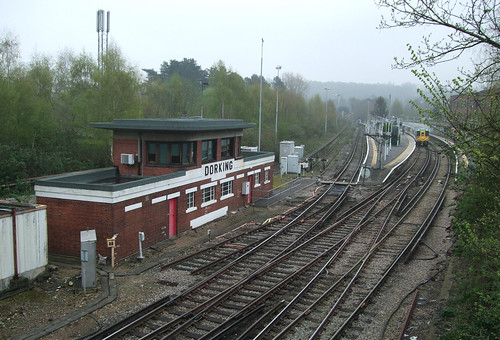
There are other connections from here too: those cycleways along Stane Street carry National Cycle Network route 22 from Banstead, on the edge of London, to the New Forest. And there are two walking routes, both developed under the aegis of another Surrey countryside partnership project, the Lower Mole Project: the Mole Gap Trail, between Dorking and Leatherhead, and the Thames Down Link, from Kingston to Box Hill. The latter runs along a section of the London Loop and connects the North Downs Way with the Thames Path, so falls well within the scope of London underfoot, and we'll reach Box Hill by it some other day -- hopefully when the mist has lifted.
View a map http://maps.google.co.uk/maps/ms?ie=UTF8&hl=en&oe=UTF8&msa=0&msid=117966169375523396049.00046414d40d8252e7b70&num=200&start=73&z=11
Route description pdf
More information
- Surrey County Council http://www.surrey.gov.uk/
- Surrey Countryside http://www.surreycc.gov.uk/countryside
- Surrey Interactive Maps http://surreymaps.surreycc.gov.uk/
- Surrey Walking (John Harris) http://www.walkinginsurrey.co.uk/
- Visit Surrey http://www.visitsurrey.com/
- Exploring Surrey's Past http://www.exploringsurreyspast.org.uk/
- Surrey Hills AONB http://www.surreyhills.org/
- Reigate & Banstead Borough Council http://www.reigate-banstead.gov.uk/
- Reigate & Banstead Parks and Countryside http://www.reigate-banstead.gov.uk/public/Leisure/Parks_countryside/
- Reigate & Banstead Tourism http://www.reigate-banstead.gov.uk/public/Leisure/Tourism/
- National Trails http://www.nationaltrail.co.uk/
- North Downs Way National Trail http://www.nationaltrail.co.uk/northdowns/
- Greensand Way http://www.kent.gov.uk/leisure-and-culture/explore-kent/walking/greensand-way-walk.htm
- Merstham http://www.merstham.co.uk/
- M25 (Wikipedia) http://en.wikipedia.org/wiki/M25_motorway
- M25 history (The Motorway Archive) http://www.iht.org/motorway/londonm25.htm
- London Brighton & South Coast Railway (Wikipedia) http://en.wikipedia.org/wiki/London,_Brighton_and_South_Coast_Railway
- Royal Alexandra & Albert School http://www.raa-school.co.uk/
- National Trust http://www.nationaltrust.org.uk/
- Gatton Trust http://www.gattonpark.com/
- North Downs (National Trust) http://www.nationaltrust.org.uk/northdowns
- Reigate Fort (National Trust) http://www.nationaltrust.org.uk/reigatefort
- Reigate (Wikipedia) http://en.wikipedia.org/wiki/Reigate
- Mole Valley District Council http://www.molevalley.gov.uk/
- Mole Valley Parks and Open Spaces http://www.molevalley.gov.uk/index.cfm?articleid=412
- Mole Valley Visitor Information Centre http://www.molevalley.gov.uk/index.cfm?articleid=380
- City of London http://www.cityoflondon.gov.uk/
- Coal Tax Posts (City of London) http://www.cityoflondon.gov.uk/Corporation/LGNL_Services/Leisure_and_culture/Local_history_and_heritage/coal_posts.htm
- Buckland Surrey http://www.bucklandsurrey.net/
- Walks around Buckland and Betchworth http://www.bucklandsurrey.net/PARISH%20COUNCIL/local_walks.htm
- Betchworth Parish Council http://betchworth-pc.gov.uk/
- North Downs Line (Wikipedia) http://en.wikipedia.org/wiki/North_Downs_Line
- Surrey Wildlife Trust http://www.surreywildlifetrust.co.uk/
- Brockham Lime Works / Betchworth Quarry http://www.surreywildlifetrust.co.uk/Default.asp?Editor=Attachment&TextElementID={4ACCD34D-4DAE-4F7A-82E7-8A2FB1C843A8}
- Brockham Village http://www.brockham.org/
- Box Hill Neighbourhood Council http://www.boxhill.org.uk/
- Box Hill for Bikes http://www.boxhill.co.uk/
- River Mole (Wikipedia) http://en.wikipedia.org/wiki/River_Mole,_Surrey
- Lower Mole Project (including Thames Down Link and Mole Gap Trail)
http://www.surreycc.gov.uk/SCCWebsite/sccwspages.nsf/LookupWebPagesByTITLE_RTF/Lower+Mole+Project?opendocument - Stane Street (Wikipedia) http://en.wikipedia.org/wiki/Stane_Street
- A24 (Wikipedia) http://en.wikipedia.org/wiki/A24_road_(England)
- National Cycle Network 22 http://www.sustrans.org.uk/default.asp?sID=1099056191265
- Denbies Wine Estate http://www.denbiesvineyard.co.uk/
- Sutton and Mole Valley Lines http://en.wikipedia.org/wiki/Sutton_%26_Mole_Valley_Line
